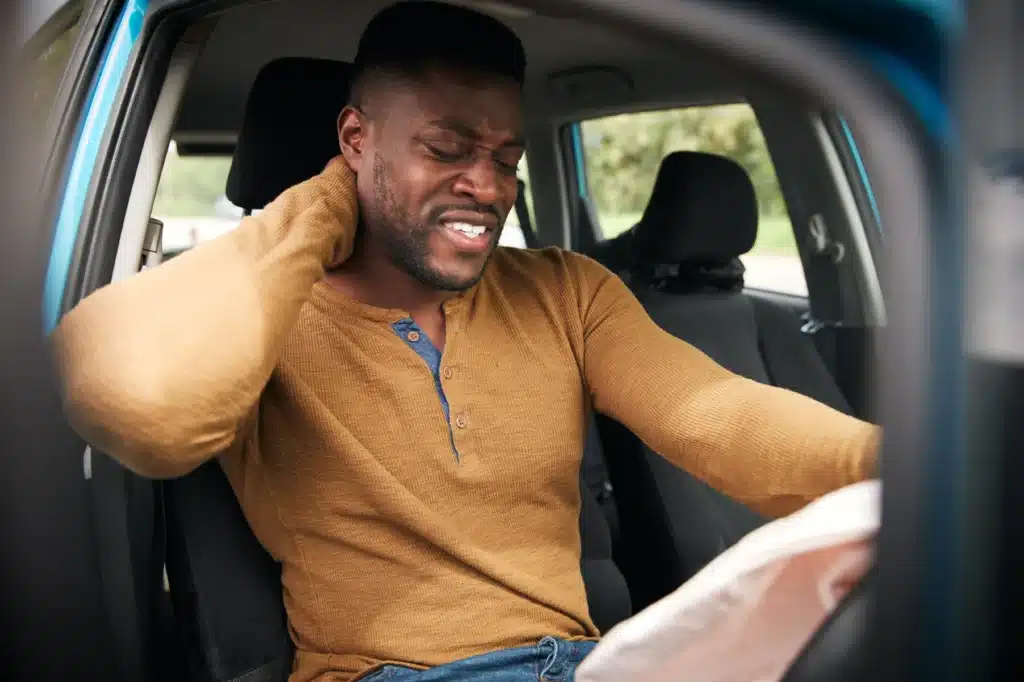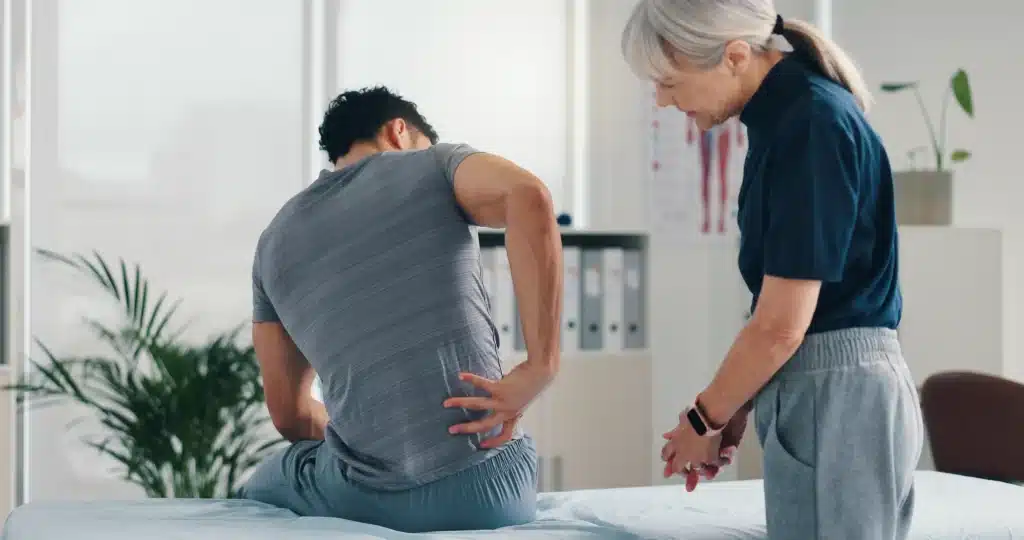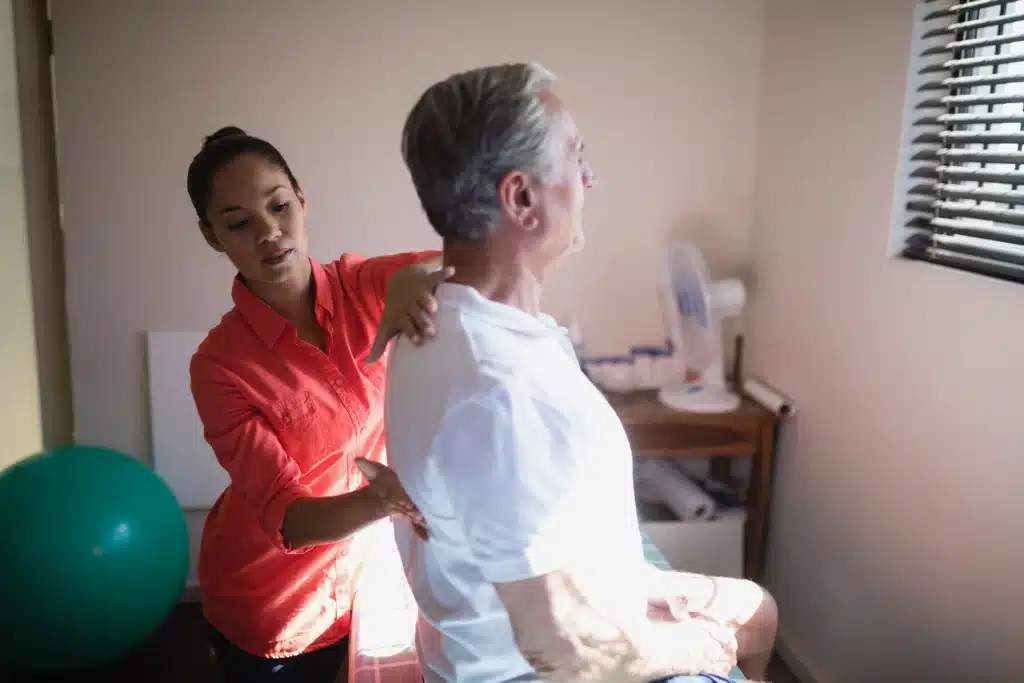
Table of Contents
ToggleBack pain from driving refers to the discomfort or pain in the lower, middle, or upper back caused by extended periods in a car. Sitting in one position for too long, especially without proper support, can compress spinal discs, strain muscles, and misalign the spine.
For many of my patients, long commutes or frequent road trips exacerbate chronic back conditions or trigger new pain. If you’ve ever felt a lingering ache after a long drive, you’re not alone.
This blog post dives deep into the causes and solutions for this common issue, drawing from my 25+ years of experience as a spine surgeon.
Driving is inherently a sedentary activity. When you’re behind the wheel, your body is fixed in one position, which increases pressure on your spinal discs.
Over time, this can lead to discomfort or even long-term spinal issues. One of the main culprits is poor posture.
Slouching forward or leaning to one side creates uneven pressure on the spine, overstretching muscles and ligaments. Another contributing factor is the vibration from the car.
Even in smooth-riding sedans, minor vibrations can fatigue spinal muscles, leading to stiffness and pain. For truck drivers or SUV owners, the impact is often amplified due to their vehicles’ rougher suspension systems.
Stress also plays a role. Concentrating on the road for long periods can tense the shoulders, neck, and back, further compounding the problem.

One of the simplest ways to combat back pain from driving is to adjust your seat properly. I often tell my patients to think of their seat as a tool for their spine.
First, ensure your hips and lower back are firmly against the seatback. This alignment minimizes pressure on the lumbar region.
Adjust the seat height so your knees are slightly lower than your hips, which promotes better circulation and reduces strain. Your steering wheel should be within easy reach.
Stretching your arms too far can pull your shoulders and strain your upper back. I recommend maintaining a slight bend in your elbows while keeping your hands at the 9 and 3 positions.
Mirrors should be adjusted to prevent unnecessary twisting of your neck. If your car lacks adequate lumbar support, consider investing in a lumbar cushion or rolling up a towel as a quick fix.
The goal is to maintain the natural curve of your spine throughout your drive.
Stretching is critical to combating back pain from driving. Before you even start your car, take five minutes to stretch. Focus on your lower back, hamstrings, and hips.
A simple forward bend or knee-to-chest stretch can help loosen tight muscles. While on the road, safe, subtle movements can make a big difference.
Pumping your ankles not only improves blood flow but also activates your hamstrings and calves. Shift your position slightly every 15–20 minutes to prevent stiffness.
For longer trips, plan breaks every hour. During these stops, I recommend walking briskly or performing gentle back extensions to counteract the effects of sitting.
After you reach your destination, a few minutes of yoga or targeted stretches can work wonders for relieving tension. Read more here.
Accessories play a significant role in reducing back pain from driving, especially for those who spend extended periods behind the wheel. Lumbar support cushions are a popular and effective solution, as they help maintain the natural curve of the lower spine, alleviating pressure on the lumbar region.
Heated seat covers can also provide much-needed relief by increasing blood flow and relaxing tense muscles, making long drives more comfortable. For drivers experiencing tailbone pain, U-shaped cushions are an excellent choice.
These cushions reduce pressure on the coccyx, providing targeted relief for those with sensitivity in this area. Additionally, anti-vibration seat pads are ideal for minimizing the impact of road vibrations, particularly for long-haul drivers or those navigating bumpy terrain.
These accessories are relatively small investments that can lead to substantial improvements in driving comfort and overall spinal health. Incorporating these tools into your car setup can transform your driving experience, ensuring that back pain becomes a thing of the past. Read more here.

Prolonged sitting, especially in the constrained environment of a car, can lead to several spinal issues. When you sit for hours, the spinal discs compress, losing some of their cushioning ability.
Over time, this can increase the risk of herniated discs or sciatica. Additionally, the lack of movement causes spinal muscles to weaken, making them more susceptible to injury.
Poor circulation is another concern. Sitting for extended periods can lead to swelling in the lower extremities, which not only causes discomfort but also impacts spinal health indirectly.
This is why regular movement and proper posture are essential for drivers who spend long hours on the road. If these habits are neglected, chronic issues like degenerative disc disease may develop.
Preventing back pain from driving requires more than just on-the-road solutions; it calls for lifestyle changes. Regular physical activity is key.
Simple exercises like planks, bird dogs, and side stretches can strengthen your core and support your spine. Maintaining a healthy weight also reduces the load on your back, particularly during long drives.
Hydration is another often-overlooked factor. Dehydration can contribute to muscle cramps and spasms, making an already uncomfortable drive unbearable.
I recommend carrying a water bottle in your car and sipping throughout the trip. Lastly, prioritizing good sleep and stress management can go a long way in keeping your spine healthy and pain-free.
For drivers embarking on long trips, taking breaks is non-negotiable. I recommend stopping every one to two hours to stretch and move around.
Use these breaks to perform stretches like back extensions or side bends, which counteract the effects of prolonged sitting. If you’re unable to take frequent breaks, make use of rest areas to incorporate short walks.
Even five minutes of walking can improve blood circulation and reduce stiffness. These habits not only alleviate pain but also contribute to overall road safety, as a more comfortable driver is a more focused one.

While home remedies can often alleviate mild to moderate back pain from driving, persistent pain may indicate an underlying condition. Red flags include numbness or tingling in the legs, persistent stiffness, or pain that worsens despite lifestyle adjustments.
Conditions like herniated discs, spinal stenosis, or degenerative disc disease may require professional intervention. At Long Island Neuroscience Specialists, our team has over 25 years of experience treating spine-related conditions.
Whether through minimally invasive procedures or physical therapy recommendations, we’re here to help you find relief. Don’t let back pain become a barrier to your daily activities—consult a specialist if needed.
Finally, adopting safe and ergonomic driving habits can significantly reduce back strain. Avoid sudden stops or sharp turns, as these jarring movements can aggravate back pain.
Smooth acceleration and braking not only protect your spine but also improve fuel efficiency—a win-win!
Keep both hands on the wheel at the 9 and 3 positions to distribute tension evenly.
If you use cruise control on highways, take advantage of the opportunity to reposition your feet and relieve lower back pressure. These small changes in technique can have a big impact over time.
While physical factors play a significant role in back pain from driving, psychological elements are equally important. Stress, anxiety, or intense focus on the road can lead to unconscious muscle tension, especially in the shoulders, neck, and upper back.
I’ve had many patients report that their back pain worsens during stressful drives, such as navigating through heavy traffic or driving in unfamiliar areas. This is why I encourage drivers to create a calming environment in their vehicles.
Listening to soothing music, audiobooks, or podcasts can help reduce stress levels. Even focusing on deep breathing while stopped at a red light can make a difference.
Over time, these techniques can help reduce the muscle tension that exacerbates back pain during drives.

Different groups of drivers face unique challenges when dealing with back pain from driving. For families embarking on long road trips, the focus should be on comfort and preparedness.
Parents should adjust the driver’s seat carefully and take turns driving whenever possible. Having a well-stocked car with cushions, snacks, and plenty of water ensures everyone’s comfort.
Professional drivers, such as truck drivers or rideshare operators, often spend hours on the road each day. For these individuals, routine maintenance of both their vehicles and their own bodies is critical.
Regular physical therapy sessions, ergonomic accessories, and strict adherence to break schedules can prevent chronic issues. These drivers should also consider workplace wellness programs, as many employers now offer resources to support spinal health.
Modern vehicles offer a range of technological features designed to enhance comfort and reduce the strain of long drives. Features like adjustable lumbar support, heated seats, and suspension systems that minimize vibration can significantly alleviate back pain from driving.
In my practice, I often recommend patients explore these options when purchasing a vehicle. For example, cars with memory settings for seat positions can be a lifesaver for those with chronic back pain.
Adaptive cruise control and lane-keeping assist also allow drivers to relax slightly during long highway stretches, reducing muscle fatigue. However, drivers should always remain attentive and avoid becoming overly reliant on these technologies.
One of the most critical lessons I’ve learned in my career is the importance of addressing back pain early. Many drivers tend to ignore mild discomfort, hoping it will resolve on its own.
However, untreated back pain from driving can lead to more serious conditions, such as sciatica or degenerative disc disease. If you notice recurring pain after driving, don’t wait to take action.
Simple adjustments, like improving your posture or incorporating regular stretches, can make a significant difference. And if the pain persists, consulting a spine specialist can help you identify the root cause and prevent long-term damage.

Building a driving routine that prioritizes spinal health requires consistency. Start by incorporating a short stretching session before getting in the car.
Ensure your seat and mirrors are properly adjusted, and keep a lumbar cushion handy for additional support. During the drive, stay mindful of your posture and make small adjustments as needed.
If you’re planning a long trip, schedule breaks in advance. Use these stops as an opportunity to stretch, hydrate, and reset your posture.
These habits may seem minor, but they can significantly improve your comfort and prevent pain over time.
Driving is an essential part of modern life, but it doesn’t have to come with the burden of back pain. By understanding the causes of back pain from driving and implementing the strategies discussed in this post, you can protect your spine and enhance your overall driving experience.
From ergonomic adjustments to lifestyle changes, there are countless ways to alleviate discomfort and prevent chronic issues. At Long Island Neuroscience Specialists, we’re dedicated to helping our patients live pain-free lives.
With over 25 years of experience in spine surgery and care, we understand the complexities of back pain and are here to guide you toward lasting solutions.
If you’re struggling with back pain, don’t hesitate to reach out to our team. Together, we can help you get back on the road to comfort and health.
GET IN TOUCH +
285 Sills Road
Building 5-6, Suite E
East Patchogue, NY 11772
(631) 475-5511
184 N. Belle Mead Road
East Setauket, NY 11733
(631) 675-6226
GET IN TOUCH +
285 Sills Road
Building 5-6, Suite E
East Patchogue, NY 11772
(631) 475-5511
184 N. Belle Mead Road
East Setauket, NY 11733
(631) 675-6226
SUBSCRIBE TO OUR NEWSLETTER +
Send us a Google review. Click this link and let us know how we did!
Review us on Yelp too.